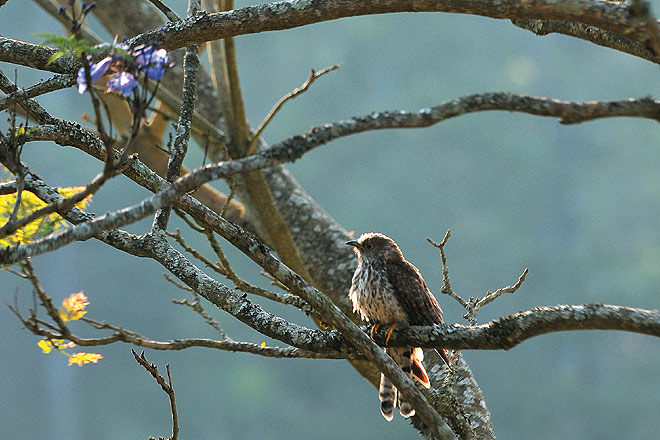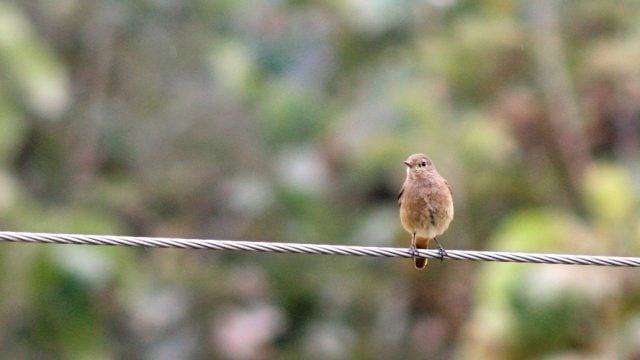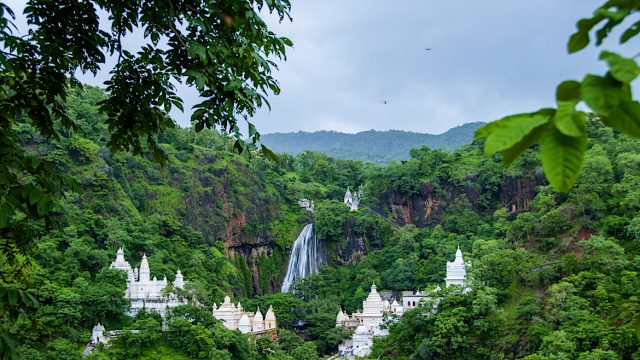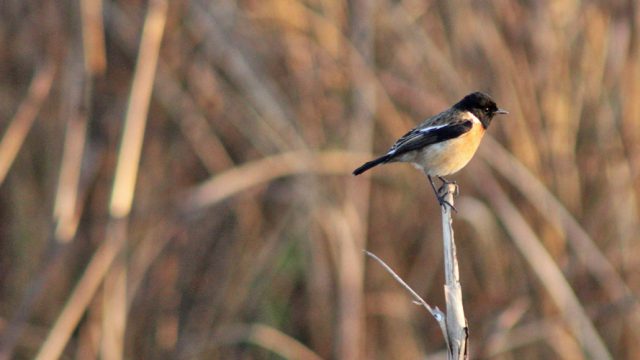I went looking for a bakery, a nondescript nook named after a famous saint to be found

The irony is not lost upon me, but when I ventured out again the next morning, with a guide to boot, it was to less successful results. Kotagiri is most agreeably chary of promoted tourism, and I wish I hadn’t given over my precious day to it. Parts of it were still fun, especially travelling by a beat-up jeep, bones rattling over unpaved paths to landscapes that would have taken me hours to reach without modern transport. We thus made our way to the Banangudi and Longwood shoal forests, extraordinarily biodiverse habitats offering splendid opportunities for birding (spotted babblers, hill mynas, grey hornbills and rackettailed drongos are more commonly seen than the great black woodpecker and Malabar trogon, I read afterward). The gated entrance to the Longwood shola was lined with neatly stacked cut trees, never a promising sight, but a forest official explained that it was part of the planned logging of exotic species (including eucalyptus and wattle), now proven to be harmful to local ecosystems, so that indigenous woodlands regenerate naturally. The absence of an expert naturalist turned the visit into a pleasant enough walk in the sylvan forest, where we also came upon megalithic nadukalai or dolmen, marked only by a board that declares them a Protected Area under the Ancient Monuments and Archaelogical Sites and Remains Act, 1958. We spotted Malabar giant squirrels darting about high on the branches of evergreen trees, and paused at a thatched Badaga shrine, which wore an air of abandonment—it is ceremonially visited by the community only once in two years for a festival, the details of which I could not discern.
Later, our guide was much enthused by visits to two tribal villages, but this sort of gawking only leaves me feeling uneasy, so I cannot recommend it. Indeed, the only thing that cheered me about the exercise was the chance to see a venerated 200-yearold selai maram, a type of fig tree, its huge girth providing room enough to set up a tent where its trunk branches out, the vast canopy of light-green leaves sounding like a waterfall as it whooshed in the wind. We also made our way to the tranquil and well-kept St Luke’s Church in town, built in 1928 by an Angus McEwan, the caretaker said. There were a couple of parks left to go on the itinerary, but I was thankful for the chance to rest my feet. Tomorrow, I promised myself, I would do nothing more than keep a look out for the sparrows that flit about everywhere, and I miss them so back home. Our escort’s undiminished zeal, however, did cause a mystery to be solved. He was able to confirm the unfortunate demise of old Francis Bakery many eons ago. I suppose he must have wondered why I was so hung up on bread when there was varki to be had. So was I introduced to the flaky tea biscuit, proudly unique to the Nilgiris, easily found in the many tiny bakeries that dot Kotagiri’s bustling little market. I got some packed, retreated gratefully, and asked for tea.

Kotagiri is best experienced quietly, agrees Frenchman Benoit Sait, who is here to “enjoy life after working hard.” It was an electrical parts business that brought the native of Alsace to India over four decades ago, and having ventured to Ooty en route to Sri Lanka in 1974, he couldn’t get the Nilgiris out of his head. He was drawn to the people and culture of southern India, he says, but was sorely disillusioned when he saw what had become of Ooty by 2007, having returned with the intention of settling thereabouts permanently. Coonoor wouldn’t do either, he decided, since it was a valley that didn’t have the sort of largish spread he wanted with hill views. He finally picked bucolic Hadathorai (1,600 metres), five kilometres out of Kotagiri (1,793 metres) and more clement than Coonoor (1,850 metres) or Ooty (2,240 metres).

Here he purchased a bungalow—originally built in 1890 by a Scotsman of the family Kay—and eight acres of land around it, mostly sloping down a valley of pristine views. Sait has lavished a lot of love and quirkiness into his homestay, now called La Maison, where geese run about a fruit-andherb garden, and sun-kissed breakfasts and starlit dinners are served in the extended living room with a roof made of glass. The boutique property sells curios and art on display, including paintings by talented local artist Gokul (thus remaining true to the original meaning of the French expression), and out in the back is a wood-fired open-air Jacuzzi with ‘360° views’ of the valley below.
People of the hills are unified by an uncommonly friendly reserve, which makes interactions both shy and congenial. Narrow roads, sometimes no more than steeply ascending rubble, lead to remote hamlets that are not accessible by any form of public transport. The rare private vehicle that rumbles past pulls over when someone is seen hiking resolutely, and Sait says he recently broke his own record while returning home one day, by accommodating no less than 21 villagers going the same way in his Mahindra Scorpio.
Sait, who leads a number of scenic treks in the vicinity, remarks that many of the mountains in the region have no name (“every hill in Europe does”), so he has named one Benny after himself and a friend, affectionately. A climb up takes a goodly three hours (shortened to two if done partly in his ‘heritage jeep’, formerly used in Bandipur) and the best reward for the effort is their signature omelette de la mere Poularde, sumptuous with cream, yet feather-light from whipped egg whites. La Maison is as much about Sait’s friendly company and superb ‘confusion cuisine’ by his wonder cook Kanchana (dosai with cream, garlic and spices, anyone?) as it is about homemade organic jams with fruits from their own orchard, and wild honey labelled by the year of harvest, an important NTFP (non-timber forest produce) for indigenous hunting communities here. Oh, as we left, Maggi, his adorable labrador, hopped into the jeep before we could, and upon vacating it obediently if reluctantly, she chased us down the road, barking loudly, her tail wagging vigorously, till she couldn’t keep up anymore.

The Point joins these unhurried and disparate efforts at attracting travellers looking for a qualitatively enjoyable stay in ‘unknown’ Kotagiri (the Wikipedia page on the panchayat town, in fact, warns readers that it has been written like an advertisement). It’s a modern hotel, all spotless beiges, browns and whites in wood and glass, rimmed by a tea garden outside its boundaries. Nibu Sayed, the friendly owner, has gone to considerable lengths to establish the sort of reliable standards we might expect from the better brands in more touristy locations. I had encountered some colourful stories of the travails faced by Kotagiri’s hotel owners by now, most of them related to supplies and trained staff, so I perceive The Point as no mean achievement. However, it’s not only the dependable wi-fi, the well-prepared multi-cuisine food, the small library and the sunny balconies that warmed my heart at this smart and literally shiny gem (it’s all that glass), but the sweet-natured and welcoming hospitality that Sayed espouses, and in this he succeeds even in his absence, for the amiable and efficient John Kennedy takes over. Oh, yes, the young man smiles, he had trouble in school with that name.
Kotagiri was the first British settlement in the Nilgiris, the destination of choice as a colonial summer retreat, till a road was built from Mettupalayam to Coonoor, and the horse trail via Kotagiri, till then the only way to connect to Ooty from the foothills, lost its usefulness. It’s now the smaller town that has found contentment in anonymity, quite perfect for seekers of a restful idyll.

Back at the Sunshine Bungalow, which gets the inspired name from its heavenly location upon the crest of a hill (I would automatically look for the switch as I left my room during the days, except it was the skylights that were flooding it with a soft glow), I awoke at dawn to an exuberant and unstoppable concerto of birdsong. Something was up. I drew back the curtains and opened the old bay-style windows to watch the sun rise over the opposite hillside, casting my room and me in the magically shifting colours of the morning. Soon, I booted up my laptop on the glass-topped dining table in the alcove, and began writing.
The information
Getting there: Coimbatore is the nearest well-connected railway station and airport. Kotagiri is 70km/1.5hrs from the airport at Peelamedu in the outskirts, and 65km/2hrs from the railway station in the busy heart of the city. Cabs cost about the same from both (Rs 2,700 for an Innova, Rs 1,800 for smaller cars like the Indigo). Frequent public transport buses are available from Coimbatore’s New Bus Stand near Saibaba Colony, a couple of kilometres from the station (busfare to Kotagiri is about Rs 40).

Where to stay: We enjoyed our stay at the Sunshine Bungalow, a simple 4-room homestay set in a charming garden, with worn furniture and beautiful wooden flooring (from Rs 4,300; +91 9787588869 / 9488770753, www.thesunshinebungalow.com). The two front-facing rooms behold ther ising sun, so be sure to prefer them. Their sister property, the Windy Gap Cottage (from Rs 12,000 for the entire 3-bed cottage, breakfast included; +91-9787588869 / 9488770753, www.windygapcottage.com), also named aptly, is ideal for small groups or families, who can have all of it to themselves. La Maison (from Rs 9,000; +91-9585857732, www.lamaison.in) has four rooms, none of them alike. Only the bathroom of the ‘honeymoon room’ has a door; the others have screens to enable wheelchair access. The Fairview Mountain Resort Villas (from Rs 6,900; 04266-211333, +91-8903192902, www.fairviewvillas.com) comprises two villas of three rooms each, set upon the crest of a sloping tea estate with fantastic views all around. The Point (from Rs 5,750; +91-9486760000 / 8489711165,www.thepointkotagiri.com) is a bright and friendly small hotel outfitted with good quality mod-cons.
Things to see & do: The Nilgiris Museum and Documentation Centre has, unfortunately, shut down due to issues between the reputed gentleman running the documentation centre and the government, which owns the heritage Sullivan Bungalow in which it is housed. The museum is expected to re-open in April and, last heard, the documentation centre perseveres in a shed nearby. There are a few notable sights in a 10-15km radius around Kotagiri, a couple of them closer. They include the Kodanad View Point, the Catherine and Elk falls, Raleigh Dam, and Rangaswamy pillar, a vertical natural rock formation rising to 400ft (there’s also a sacred peak by the same name). Ooty and Coonoor can be day trips.

Visitors to the Longwood and Banangudi sholas need prior permission from the Eco Tourism Development Centre at the Range Office near the entrance to Longwood shola (Rs 100 per person; the office is mostly open all days from about 9am to 5pm).
Nature-Watch’s A. Bhoopathy claims to be the only professional guide in Kotagiri. He is recommended by everyone almost by default, is locally knowledgeable, and gains entry to most things, but be prepared more for bluster than expertise (Rs 2,000 for 5hrs of local sights plus camera and reserve forest entrance fees, and transport costs; +91-9786971735, [email protected]).

Later, a knowledgeable local boy recommended naturalist Aggal Sivalingam (+91-9486530021; Rs 1,000 for guided walks of a couple of hours each at the two shola forests, plus entrance fees, for groups of 6-7, the ideal maximum). He doesn’t live in Kotagiri though he covers it, and I heard he is especially good with birdwatching.
flora and fauna
Kotagiri
the Nilgiris
Leave a Reply
You must be logged in to post a comment.





